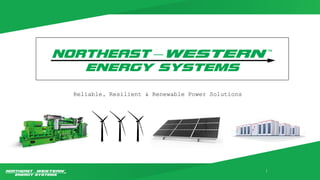THE 3 R’S (RELIABLE, RENEWABLE, RESILIENT ENERGY SUPPLY) OF AN EV CHARGING STATION
The document discusses electric vehicle (EV) charging infrastructure and the transition to electric vehicles. It notes that 90% of light-duty vehicles would need to be electric by 2050 to meet climate targets. This could require all new car sales to be electric as early as 2035 based on California's target. The document discusses the increasing electricity demand from EVs, with projections of 3.5 MW in 2025 and 23.5 MW in 2030 for California alone. It also discusses using microgrids to provide reliable, resilient, and renewable power for EV charging stations. Microgrids could sell excess capacity back to the electric grid and reduce operating costs. The document provides an example economic analysis of a truck stop EV charging station powered by

Recommandé
Recommandé
Contenu connexe
Tendances
Tendances (17)
Similaire à THE 3 R’S (RELIABLE, RENEWABLE, RESILIENT ENERGY SUPPLY) OF AN EV CHARGING STATION
Similaire à THE 3 R’S (RELIABLE, RENEWABLE, RESILIENT ENERGY SUPPLY) OF AN EV CHARGING STATION (20)
Plus de DesignTeam8
Plus de DesignTeam8 (20)
Dernier
Dernier (20)
THE 3 R’S (RELIABLE, RENEWABLE, RESILIENT ENERGY SUPPLY) OF AN EV CHARGING STATION
- 1. Reliable, Resilient & Renewable Power Solutions 1
- 2. The 3 R’s of EV Charging 2 RESILIENCY RELIABILITY RENEWABLE
- 3. The 3 R’s of EV Charging 3 • Published in the journal nature climate change, the study by engineers at the University of Toronto concludes that 90% of light-duty cars on American roads would need to be electric by 2050 to keep the transportation sector in line with climate mitigation targets. • That might mean requiring all of the nation’s new car sales to be electric as early as 2035, the state target established by California gov. Gavin Newsom (D) in an announcement last week.
- 4. The 3 R’s of EV Charging 4
- 5. The 3 R’s of EV Charging 5 2025 Maximum Demand 3.5 MW 2030 Maximum Demand 23.5 MW CALIFORNIA
- 6. The 3 R’s of EV Charging 6 • Infrastructure would be capable of supporting the 3.5 MW load in 2025 • The grid has adequate capacity to supply this load at most of the charging sites identified in 2025. • Rural sites would have more difficulty meeting the projected load demand and would likely need additional infrastructure improvements. • By 2030, the larger projected 23.5 MW loads for MD/ HD charging sites would require more extensive improvements at nearly every site • New feeders, generally dedicated to the charging site load, substation transformers, and other improvements, • Transmission system improvements at some locations, would be required. • The 2 mw fast chargers have the potential to severely affect the grid because of the high electrical demand.
- 7. 7 The 3 R’s of EV Charging Total added Demand by 2030 = 936 MW Equivalent to 1 U.S. Nuclear Reactor CALIFORNIA
- 8. The 3 R’s of EV Charging 8 Congestion PJM NY-ISO
- 9. 9 EV Charging Stations A microgrid provides: • Economic benefits vs grid power • Resiliency in energy supply • Reliability in sources of electricity • Implementation of Renewable technology • Economies of scale via standardization of product Building a profit center from EV charging stations – Economic Dispatch Existing, dynamic, and growing marketplace • Sell EV charging microgrid capacity back to grid • $500k/year per 20MW microgrid in revenue through selling capacity to grid Reasonable assumptions: 4 hrs./day, based on 2022 off-peak pricing, 50% diversity factor Meet customer need Satisfy stakeholders Optimize opex Platforming approach The 3 R’s of EV Charging Facility power & EV charging infrastructure
- 10. The 3 R’s of EV Charging 10 • A containerized approach fits spatial characteristics and travel stop layout • 20MW displaces fewer than 10 parking spots (green) • Batteries located in unused area (blue) • Depending on land availability, the solar tech is greenfield, dispersed, or carport design • Fully integrated microgrid with standard components • Standard gensets with all benefits of commonality • Works regardless of Grid Constraints • Potential to run on Hydrogen or Renewable Natural Gas for low to no carbon footprint
- 11. 11 Client: Confidential 2 MW Charger 4 per lanes location 9 minutes to charge 50 vehicles per lane per day 3.125 vehicles per hour per lane 16 Hours of trucks charging 300 kWh per charge 180 Miles between Charges 60,000 kWh per day 21,900 MWh/year Natural Gas Debt Service ($1,183,264) Operating Cost ($1,600,876) Total kWh 21,900,000 $/kWh 0.1271 Carbon Reduction Lbs. /mile 1.951 Assume 95,000 miles/year lbs. carbon reduced/year 185,364.18 lbs. carbon reduction RNG Debt Service ($1,183,264) Operating Cost ($3,292,580) Total kWh 21,900,000 $/kWh 0.2044 Carbon Reduction lbs./mile 4.789 Assume 95,000 miles/year lbs. carbon reduced/year 454,942.09 lbs. carbon reduction 180 Miles on a charge 6.5 Miles per gallon Diesel $3.569 per gallon diesel Cost per 180 miles W Bat cost per charge $44.22 W/O Bat cost per charge $38.14 RNG cost per charge $61.31 Diesel Cost per 180 miles $98.83 The 3 R’s of EV Charging
- 12. The 3 R’s of EV Charging 12 TYPICAL EV SYSTEM COMPONENTS • 2 MW SOLAR FIELD OR CARPORTS • 20 MWH BATTERY STORAGE • 20 MW ENGINES TO RUN ON NG, RNG OR H2
- 13. The 3 R’s of EV Charging 13 VIRTUAL RNG FINANCIAL TRANSACTION – NO PHYSICAL DELIVERY • System connects to existing natural gas infrastructure • Site contracts with 3rd party rng manufacturer who delivers rng to pipeline • Site owner & rng manufacturer execute a contract for differences (cfd) that sells emissions attributes to site owner
- 14. The 3 R’s of EV Charging 14 QUESTIONS Joseph Martorano P.E. Vice President – Engineering & Project Management Northeast-Western Energy Systems C: 215.514.3261 O: 267.817.9862 jmartorano@nes-wes.com 8330 State Road Philadelphia, PA 19136